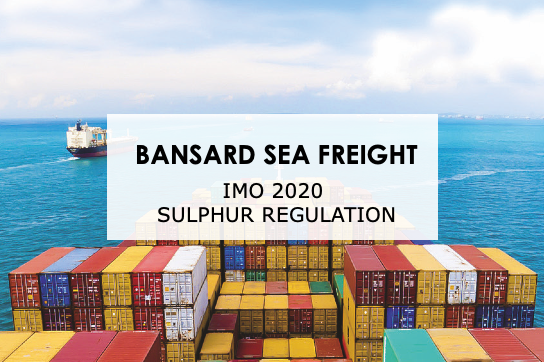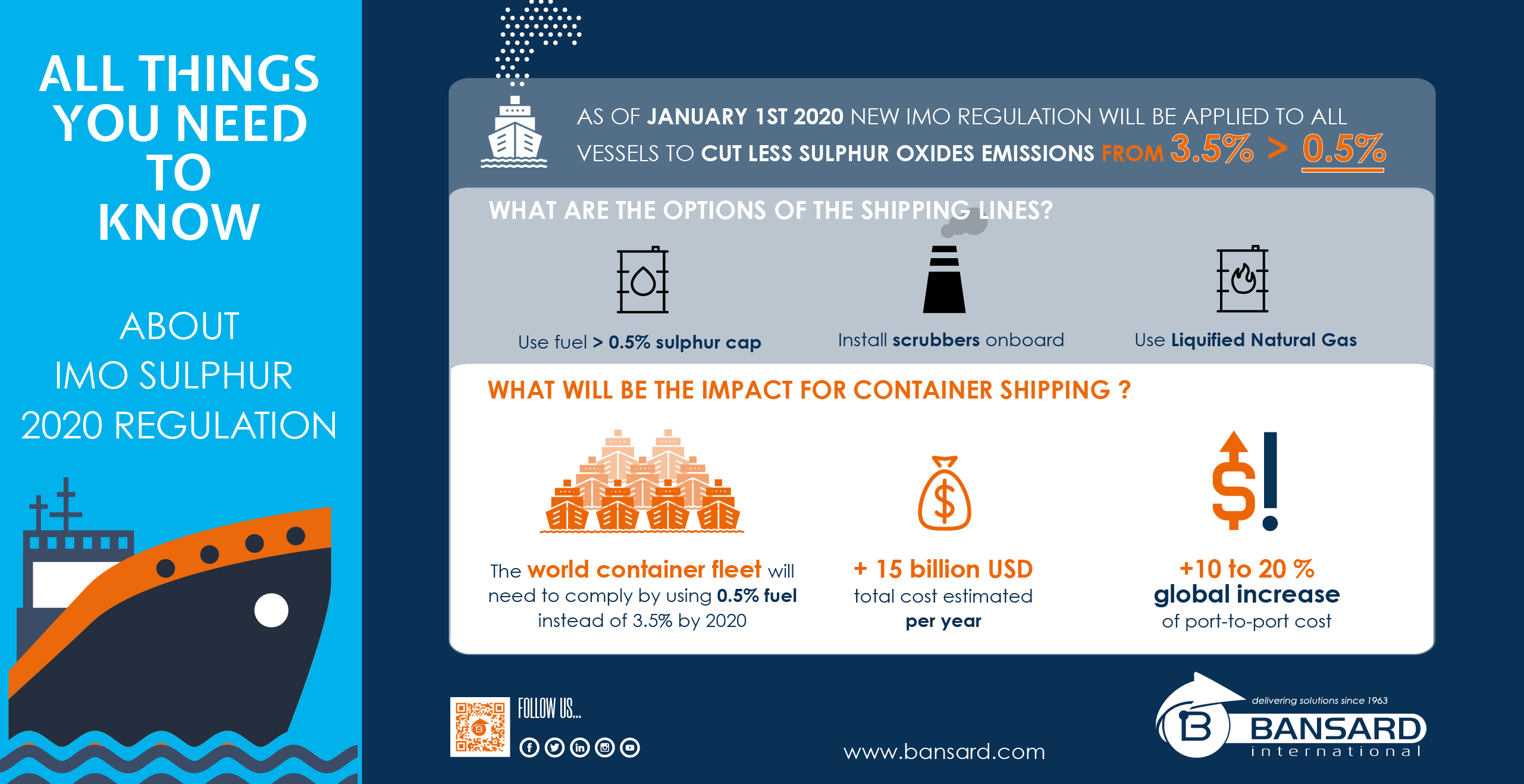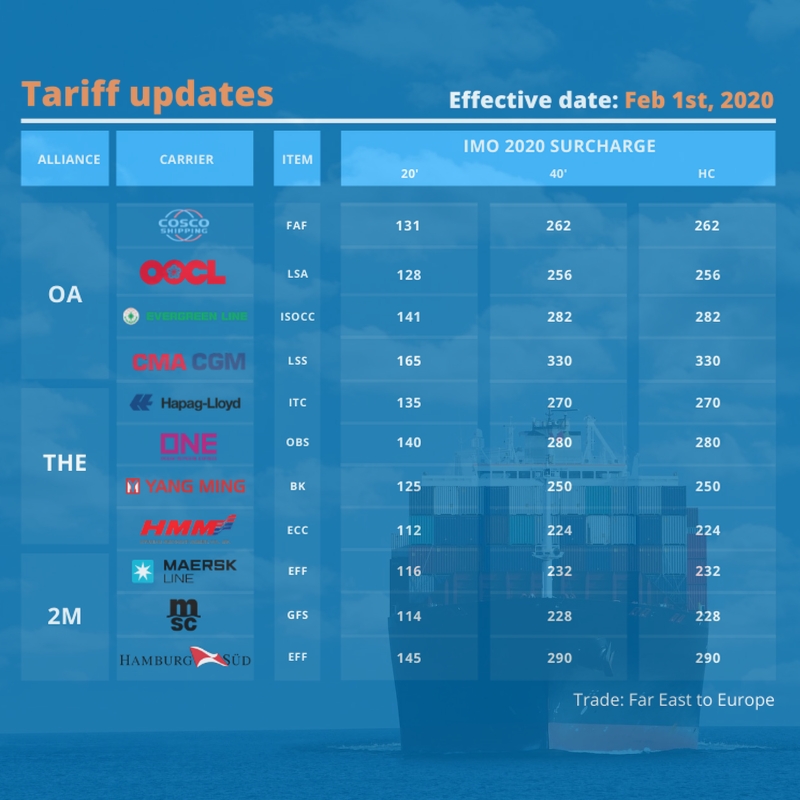The International Maritime Organization (IMO) has ruled that from january 1st 2020, sea freight industry emissions in international waters be lowered. The sea freight sector will have to reduce sulphur emissions by over 80%.


What you need to know!
What does IMO Sulphur 2020 stand for?
The IMO, as the United Nations' arm of the safety and performance in the shipping industry, has set up this new fuel sulphur regulation. Going from the today allowed maximum fuel oil sulphur limit of 3.5 % (weight in the fuel) will fall to 0.5 %. As part of the UN, this regulation is global and all the vessels (all shipping lines) will have to comply by, and this will have a large-scale impact on the refining, bunkering and shipping industries. In total, this regulation will reduce sulphur pollution by 80%.
Why is IMO 2020 has been enacted and what will be the environmental outcomes?
Historically, the shipping industry has always been an important contributor to harmful emission. In 2017 it's been recorded that the marine sector consumed around 3.8 million barrels a day, responsible for an important part of global fuel oil demand. This industry reduction of sulphur emissions will have both benefits for human health by reducing respiratory and cardiovascular diseases in the cities close to ports and coastal areas and environmental as the occurrence of acid rains and soil erosions should, therefore, be reduced.
How are shipping lines preparing for 2020?
Carriers have only 3 main and viable options to achieve IMO 2020 standards compliances. All the three solutions are consequently expensive but remain mandatory, which let them few options:
- OPTION #1: buy IMO 2020-compliant fuels replacing high sulphur fuel oil (HSFO) by low sulphur fuel oil (LSFO), marine gas oil (MGO) and various low sulphur blends of gas oils and residuals, which all fall under the 0.5% sulphur cap. This approach will be the most straightforward and easiest solution despite the cost which is 50% more expensive than HSFO, which could also lead to an MGO fuel shortage.
- OPTION #2: install exhaust gas cleaning system (also calls "scrubbers") on their ships and still burn the same fuel as the HSFO.
- OPTION #3: switching propulsion systems to other fuels such as liquified natural gas (LNG) instead of fuel for example. LNG is a fully compliant solution but involves a larger investment in transitioning vessels to LNG fuel. Globally it remains a good alternative for new-build vessels nevertheless the lack of "gas port stations" and the forecast of LNG shortage could remain a barrier.
In a longer-term, alternative fuels like biofuel may be also part of the solution. The total cost to meet this regulation has been estimated from The LoadStar at minimum USD 15 billion per year for the shipping lines, top carriers as Maersk and MSC determined that their direct cost will be approximately USD 2 billion each per year, so between USD 100 to USD 175 per TEU (according to the transit time).
What are the impacts to predicts?
First of all, Bansard International Group fully supports this regulation, this regulation is a significant step forward in our industry and will be a significant benefit to human health and the environment.
According to our expertise in Sea Freight and our long partnerships experience with shipping lines, we can ensure that the shipping industry cannot directly absorb this increased cost. It will be passed on the end-users resulting in a global increase of ocean freight, whatever the chosen options previously mentioned by the shipping lines. The price impact should be felt from the end of 2019 on and last for few years, we estimate that the port-to-port cost will increase from 10 to 20% according to the routes, which could directly lead to a direct increase to the end-consumers.
The global capacity will also be reduced. Due to, in one hand and at a shorter term, for updating the vessels to the IMO 2020 regulations and on the other hand in longer-term, to the phased out of old vessels and the practice of slow steaming to save fuel consumption which could lead to lengthen transit times and create service disruptions.
As a coming surge of demand for MGO is forecasting the price will increase, and the carriers will set up (according to their own IMO 2020 preparation) to more frequent emergency bunker surcharges (EBS) or a Specific Low sulphur bunker surcharge at charges of the shippers.
Tariff surcharge according to maritime companies?

Bansard International teams will continue to inform customers of the evolution of this regulation implementation and support them in making them aware of all the potential impacts. If you have any more question regarding the IMO 2020 regulation or want to know more our sea freight solutions, our teams remain at your disposal!



